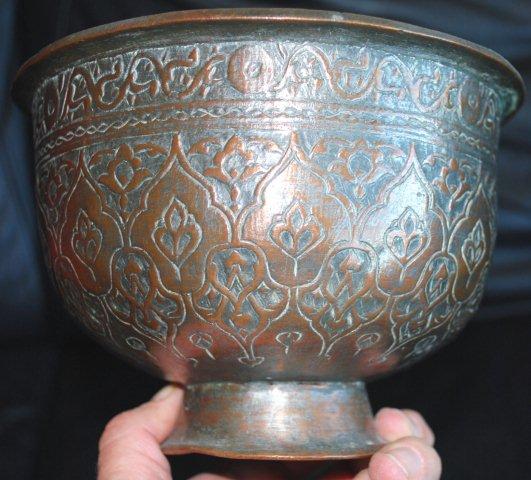Eleven different pieces of copper ware with with Persian Safavid designs. As Oman has been occupied for long periods in the 17th century it is difficult to determine if these items are Omani or Persian. There were also a few Persians working in the Omani souqs in the 17th century (see eyewitness account Padtbrugge) The designs are definitely 17th century Persian (Safavid) for many similar examples see the book by Melikian (ref 1)
- The first bowl is very shallow and with a beautiful detailed designs (not made of bell metal)
- The larger wine-bowls (!) are mostly cast from copper, (if you tick against them they ring like a bell) and subsequently engraved.
- The small cups maybe coffee cups or water-cups used by Hindu (see below)
- None of the "Persian" copper found in Oman had human figures in its decoration

Very fine designs (but very worn) , probably a very old piece

The fine design on the foot is found on other old pieces e.g. Ref 1 page 311 fig 138 and also Ref 1 page 331 fig 151.

In the 1830´s wine grapes and wine (Wellsted (ref 5) calls it shirazzi) were produced in large quantities on the Jebel Akhdar mountain plane see Travels in Arabia Volume 1 by Wellsted. In fact the vineyard area on the Jebel Akhdar planes was also called Shiraz (close to the current village named Saiq) Hence the wine bowl explanation is very plausible! Around 1830 Oman was a wine exporting nation according to Wellsted! In Yemen these bowls are also occasionally found but with very diluted designs (later copies? ) They were said to be used for pouring water in the Hamman. Dating is also difficult, but generally speaking the more "diluted" the Safavid design the more recent the copper-ware (see for example e.g. ref 3) Around 1850 the American Joseph Osgood visited Muscat and he wrote: "When traveling every Banian (=Hindu) carries his own bell-metal goblet or bowl to drink from, and should he chance to leave this article of personal property behind he would abstain altogether from the use of liquids. Should his supply of water be exhausted during a long passage, he would prefer death to life saved by drinking from a vessel polluted by persons of a different religion, and at an expense of his caste, to be deprived of which he considers is a loss of the comforts of his religion and all its supposed benefits after death"

Wellsted 1842: Village named Shirazi on the Jebel Akhar. At that time grapes were grown on the Jebel Akhdar and wine produced! Nizzuwah is Nizwa.
Carter ref 3 page 11 has an illustration of two later wine-bowls and says: the two bowls, called Shiraziyah in Oman, also purport to have been made at Nizwa possibly the beginning of this century . Comment the bowls shown are made of cast copper and subsequently engraved

Antique Persian Wine Bowl from Nizwa
Similarities with wine bowl in Western Iranian style from Kashmir ref 1 page 351 fig 165

Antique Persian bowl
Some familiarities with a bowl from Khorasan / Herat ref 1 page 279-280 fig 117

Very fine Safavid designs on this small tinned bowl, a very old piece
Westen Iran: Top border decoration identical to the bowl ref 1 page 335 fig 154a

Antique Islamic metal-ware (text not deciphered)